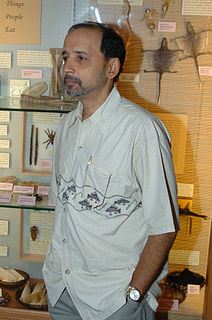
Arachnida is a class of joint-legged invertebrate animals (arthropods), in the subphylum Chelicerata. Arachnida includes orders containing spiders, scorpions, ticks, mites, harvestmen, and solifuges. In 2019, a molecular phylogenetic study also placed horseshoe crabs in Arachnida.

Wolf spiders are members of the family Lycosidae, from the Ancient Greek word "λύκος" meaning "wolf". They are robust and agile hunters with excellent eyesight. They live mostly in solitude and hunt alone, and do not spin webs. Some are opportunistic hunters pouncing upon prey as they find it or even chasing it over short distances. Some wait for passing prey in or near the mouth of a burrow.

Jumping spiders or the Salticidae are a family of spiders. As of 2019, it contained over 600 described genera and over 6000 described species, making it the largest family of spiders at 13% of all species. Jumping spiders have some of the best vision among arthropods and use it in courtship, hunting, and navigation. Although they normally move unobtrusively and fairly slowly, most species are capable of very agile jumps, notably when hunting, but sometimes in response to sudden threats or crossing long gaps. Both their book lungs and tracheal system are well-developed, and they use both systems. Jumping spiders are generally recognized by their eye pattern. All jumping spiders have four pairs of eyes, with the anterior median pair being particularly large.

Huntsman spiders, members of the family Sparassidae, are known by this name because of their speed and mode of hunting. They are also called giant crab spiders because of their size and appearance. Larger species sometimes are referred to as wood spiders, because of their preference for woody places. In southern Africa the genus Palystes are known as rain spiders or lizard-eating spiders. Commonly they are confused with baboon spiders from the Mygalomorphae infraorder, which are not closely related.

The Araneomorphae are an infraorder of spiders. They are distinguished by having chelicerae (fangs) that point diagonally forward and cross in a pinching action, in contrast to the Mygalomorphae, where they point straight down. Most of the spiders that people encounter in daily life belong to the Araneomorphae.
Marengo is a genus of Asian jumping spiders that was first described by George and Elizabeth Peckham in 1892. The name is derived from Marengo, a village in Italy and the name of Napoleon's horse.

Onomastus is a genus of Asian jumping spiders that was first described by Eugène Louis Simon in 1900. It is the only genus in the subfamily Onomastinae.
Pachyonomastus is a monotypic genus of East African jumping spiders containing the single species, Pachyonomastus kittenbergeri. It was first described by Lodovico di Caporiacco in 1947, and is only found in Africa. The name is a combination of the Ancient Greek παχύς ("pachys"), meaning "thick", and the related genus Onomastus. The species is named in honor of Kálmán Kittenberger, who collected the species.

Tarantulas comprise a group of large and often ″hairy″ spiders of the family Theraphosidae. Currently, about 1,000 species have been identified. The term tarantula is usually used to describe members of the family Theraphosidae, although many other members of the same infraorder (Mygalomorphae) are commonly referred to as "tarantulas" or "false tarantulas". Some of the more common species have become popular in the exotic pet trade. Many New World species kept as pets have urticating hairs that can cause irritation to the skin, and in extreme cases, cause damage to the eyes.
Onomastus of Smyrna was the first Olympic victor in boxing at the 23rd Olympiad, 688 BC, when this sport was added. According to Philostratus, Pausanias and Eusebius, Onomastus was not only the first Olympic boxing champion but he wrote the rules of Ancient Greek boxing as well. Pausanias adds that Smyrna was already then part of Ionia..

Spiders are air-breathing arthropods that have eight legs, chelicerae with fangs generally able to inject venom, and spinnerets that extrude silk. They are the largest order of arachnids and rank seventh in total species diversity among all orders of organisms. Spiders are found worldwide on every continent except for Antarctica, and have become established in nearly every habitat with the exceptions of air and sea colonization. As of July 2019, at least 48,200 spider species, and 120 families have been recorded by taxonomists. However, there has been dissension within the scientific community as to how all these families should be classified, as evidenced by the over 20 different classifications that have been proposed since 1900.

Rohan David Pethiyagoda, is one of Sri Lanka's leading naturalists and a taxonomist on Freshwater fish of Sri Lanka.
The World Spider Catalog (WSC) is an online searchable database concerned with spider taxonomy. It aims to list all accepted families, genera and species, as well as provide access to the related taxonomic literature. The WSC began as a series of individual web pages in 2000, created by Norman I. Platnick of the American Museum of Natural History. After Platnick's retirement in 2014, the Natural History Museum of Bern (Switzerland) took over the catalog, converting it to a relational database.
Onomastus nigricaudus, is a species of spider of the genus Onomastus. It is endemic to Sri Lanka.
Onomastus pethiyagodai, is a species of spider of the genus Onomastus. It is endemic to Sri Lanka. The specific name pethiyagodai is for in honor of Sri Lanka's one of leading zoologist Dr. Rohan Pethiyagoda.
Onomastus quinquenotatus is a species of spider of the genus Onomastus. It is endemic to Sri Lanka.
Onomastus corbetensis, is a species of spider of the genus Onomastus. It is endemic to Sri Lanka.
Onomastus jamestaylori, is a species of spider of the genus Onomastus. It is endemic to Sri Lanka.
Onomastus maskeliya, is a species of spider of the genus Onomastus. It is endemic to Sri Lanka. Onomastus maskeliya inhabits high altitude cloud forests, as a result, its distribution is limited.








